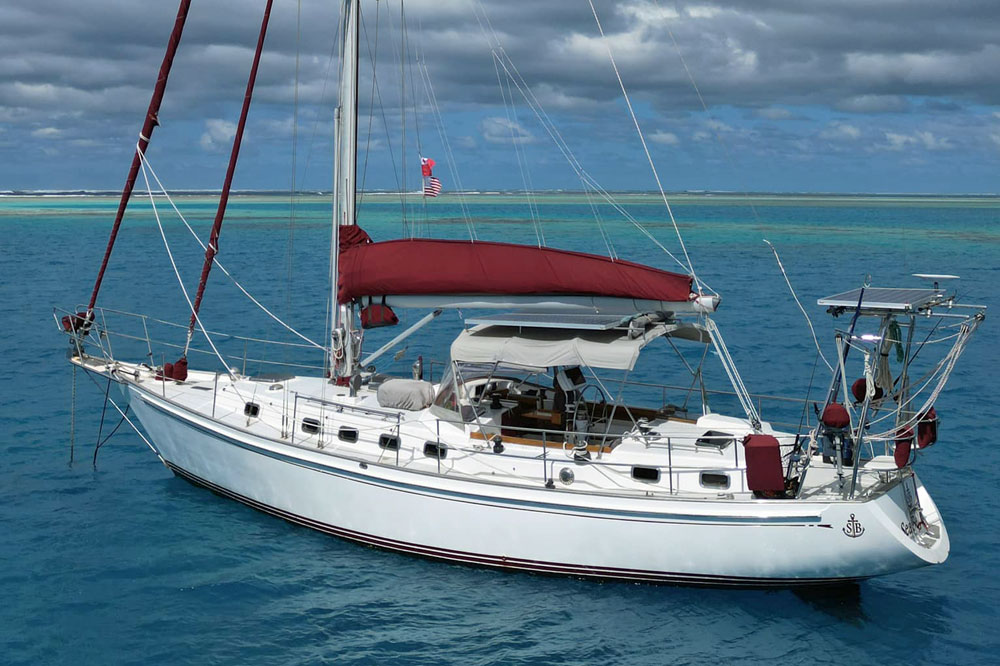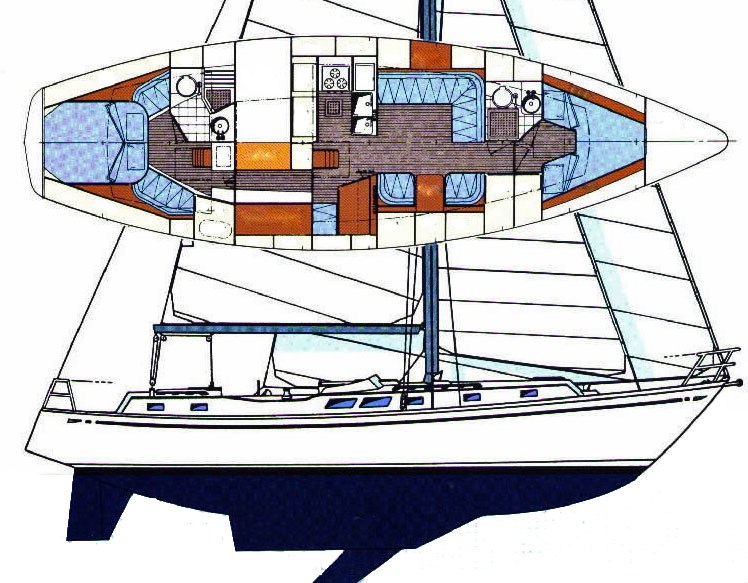- Home
- Cruising Yachts 40' to 45'
- Brewer 44 Sailboat
The Brewer 44 Sailboat
Specs & Key Performance Indicators
The Brewer 44 is a heavy-displacement sailboat designed by Canadian naval architect Ted Brewer. It was constructed by Fort Myers Yacht & Shipbuilding, a boatbuilding company based in Fort Myers, Florida.
It has a reputation as being a robust and seaworthy vessel, reflecting Brewer's expertise in designing high-performance cruising yachts and the builder's reputation for quality craftsmanship.
 A Brewer 44 MkII
A Brewer 44 MkIIPublished Specification for the Brewer 44 Sailboat
Keel & Rudder Configuration: Fin keel with a skeg-hung rudder
Hull Material: Fiberglass
Length Overall:13.41m (44' 0")
Waterline Length:10.18m (33' 5")
Beam: 4.06m (13' 4")
Draft: 1.83m (6' 0")
Rig Type: Cutter rig
Displacement: 12,927kg (28,500lb)
Ballast: 5,443kg (12,000lb)
Designer: Ted Brewer
Builder: Fort Myers Yacht & Shipbuilding
Year First Built: 1983
Year Last Built: 1989
Number Built: Approximately 60
 The Brewer 44 Accommodation Plan & Elevation
The Brewer 44 Accommodation Plan & ElevationTed Brewer is renowned for his well-mannered, attractive, and practical cruising sailboat designs. Besides the Brewer 44, he has designed other notable sailboats, including the Whitby 42, the Brewer 12.8, and various other models built by different manufacturers.
The Brewer 44 shares the same basic hull and deck as the Whitby 42, which was designed in 1971. However, some modifications were made to improve performance. For instance, the long keel and attached rudder were replaced with a more modern short keel and skeg-mounted rudder, reducing wetted surface and enhancing light airs performance. Additionally, a high aspect-ratio centerboard was added to improve windward performance.
During its production run, an extended Brewer 44 with a swim platform was introduced in 1987 and produced until 1990. This MkII version provided additional space and convenience for swimmers and crew, and made boarding from the dinghy easier.
Published Design Ratios for the Brewer 44 Sailboat
- The Sail Area/Displacement Ratio of 16.3 indicates that the Brewer 44 has reasonably good performance capabilities. It is situated on the lower end of the "reasonably good performance" range (16 to 20), suggesting it has enough sail power to perform well under various sailing conditions, though it was not designed as a high-performance racer.
- With a Ballast/Displacement Ratio of 41.4, the Brewer 44 tends to be a stiffer and more powerful boat. This ratio suggests that it will handle winds well and provide a stable platform, reducing heeling and making for a more comfortable sailing experience. However, see note 1 below.
- The Displacement/Length Ratio of 302 indicates that the Brewer 44 is a heavy displacement boat. Boats in this category typically have a deeper and rounder hull form, leading to a more comfortable but slower ride compared to lighter displacement boats. This ratio suggests that the Brewer 44 is built for stability and comfort, rather than speed.
- The Comfort Ratio of 37.1 places the Brewer 44 in the range associated with moderate bluewater cruising boats (30-40). This means that its motion in waves is moderate and likely to be comfortable for most sailors, making it suitable for extended cruising and living aboard.
- A Capsize Screening Formula of 1.8 indicates that the Brewer 44 is well-suited for ocean passages and has good bluewater capability. This low value reflects a design that minimizes the risk of capsize, which is vital for safety in offshore sailing.
Notes:
1. Ballast/Displacement Ratio Limitations:
While a higher ballast/displacement ratio generally indicates a stiffer boat, this ratio does not account for the ballast's positioning. A boat with a deep keel and a bulb at the bottom can be much stiffer and perform better than another with the same ballast ratio but with a shallow draft keel. Therefore, achieving optimal performance and stability involves more than just the ballast/displacement ratio; it also requires considering the design and placement of the ballast.
2.Ted Brewer's Comfort Ratio Limitations:
The Comfort Ratio favours heavy, narrow-beamed vessels with long overhangs, characteristic of traditional bluewater cruisers. Modern light-displacement, beamy cruisers with plumb bows may not score well on this ratio but can still offer significant comfort and bluewater capability. The Comfort Ratio doesn't fully appreciate innovations in boat design that enhance stability and comfort without resorting to heavy displacement. Thus, it might not give a complete picture of the actual comfort level on more modern, innovative yacht designs.
In summary, while the Brewer 44's design ratios indicate it is a stable, comfortable, and capable bluewater cruiser, the theoretical nature of these ratios means they should be used in conjunction with other design details and real-world performance evaluations to get a comprehensive understanding of the vessel's overall capability.
What the Yachting Press had to say about the Brewer 44
Practical Sailor, in their April 2020 review, tells us...
"The Brewer 44 is the same boat as the 12.8, with the stern extended slightly, increasing the size of the aft stateroom. This has the fortunate side effect of making the boat slightly narrower aft and reducing the size of the transom. Read more..."
This article was written with the assistance of Gemini, a large language model developed by Google. Gemini was used to gather information, summarize research findings, and provide suggestions for the content and structure of the article.
Recent Articles
-
Modern Boat Electronics and the Latest Marine Instruments
Dec 20, 25 05:27 PM
Should sailboat instruments be linked to the latest boat electronics as a fully integrated system, or is it best to leave them as independent units? -
Hans Christian 43: Classic Bluewater Cruiser & Liveaboard Sailboat
Dec 10, 25 04:37 AM
Explore the Hans Christian 43: a legendary heavy-displacement, long-keel sailboat. Read our in-depth review of its specs, design ratios, and suitability for offshore cruising and living aboard. -
Planning Your Sailboat Liveaboard Lifestyle: An Ocean Sailor's Guide
Dec 06, 25 05:18 AM
Seasoned sailors share their methodical risk analysis for planning a secure Sailboat Liveaboard Lifestyle, covering financial, property, and relationship risks.












